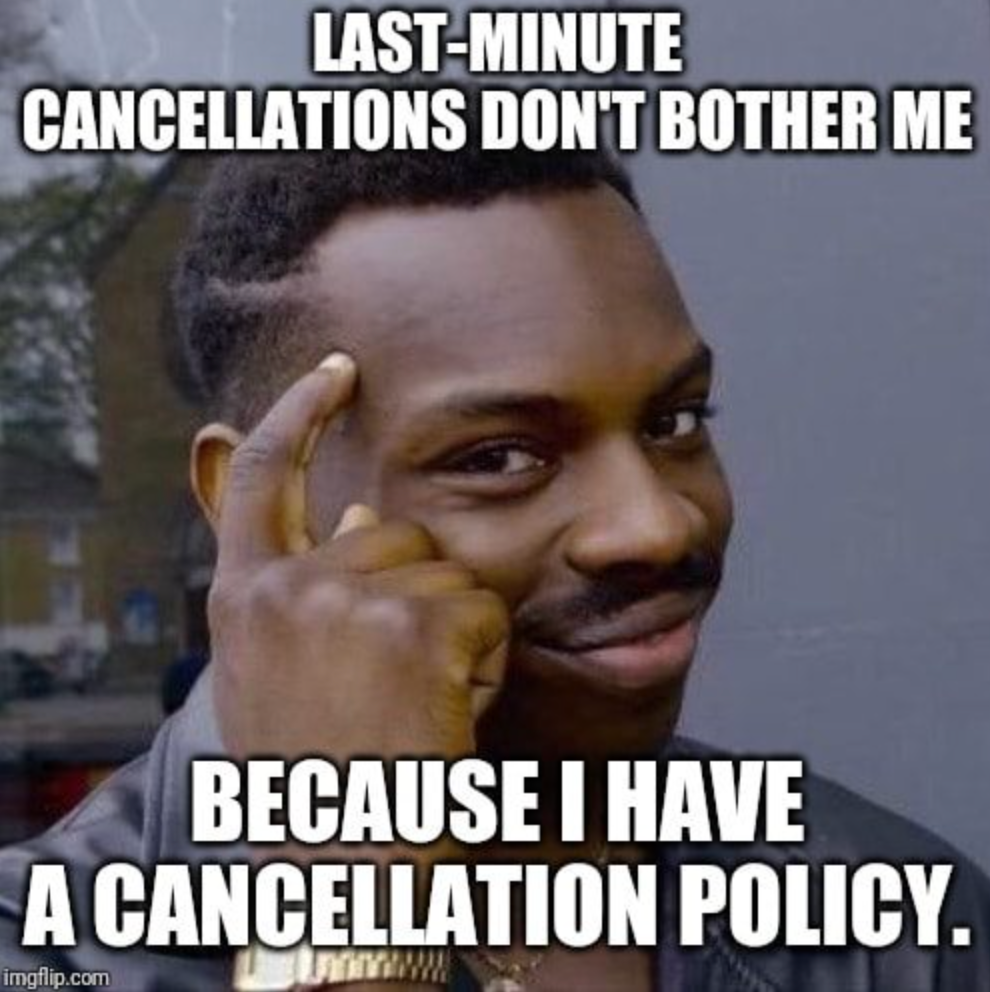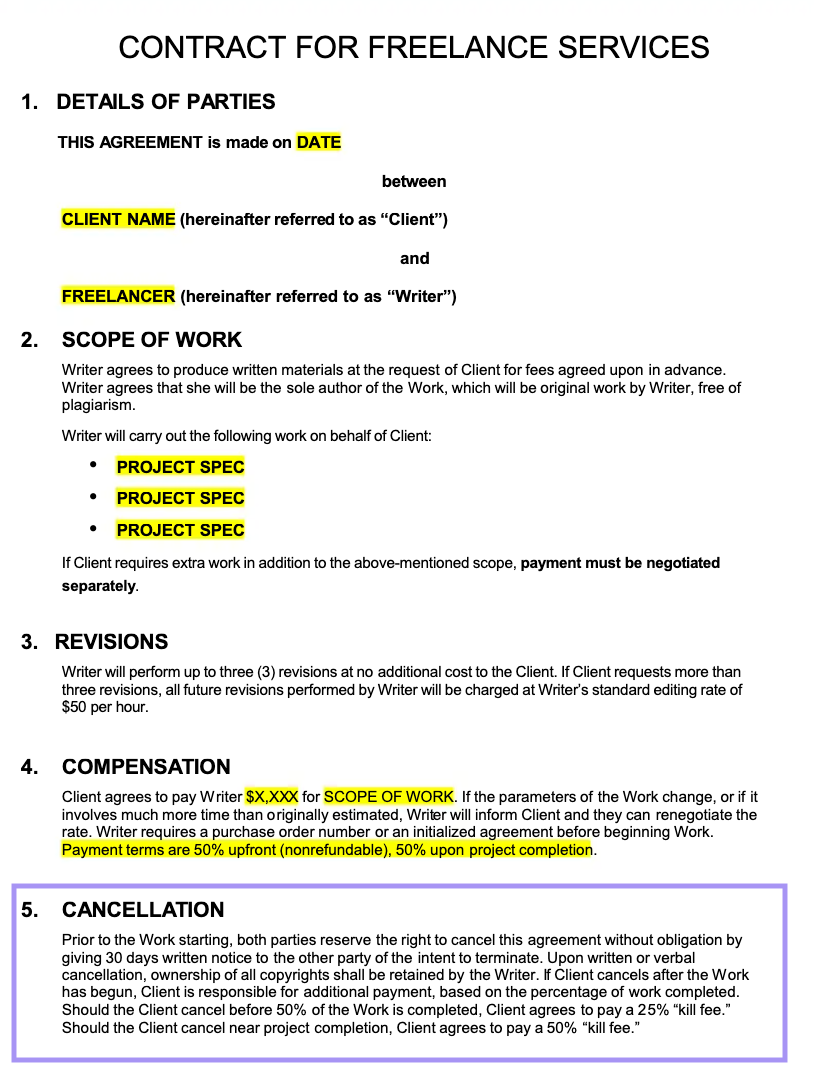Kill Fee Demystified: Understanding It in Freelance Work
Discover what kill fees are in freelance work, why they matter, and the alternatives to protect your time and budget.
October 3, 2025
October 3, 2025

Key Points
- A kill fee is a clause in your contract that compensates freelancers if a project is cancelled after work has started.
- For freelancers, kill fees protect their time and budget, but they can feel controversial to some clients.
- Some freelancers swear by kill fees, while others prefer different methods of protecting themselves.
- Milestone payments and deposits are common alternatives to kill fees.
In freelance life, projects don’t always go as planned. A client might change their mind, cancel halfway through, or simply disappear. That’s where a kill fee comes in. A kill fee is a part of your contract that compensates for your time if the project is cut short. In this article, I’ll break down what kill fees are, why they matter, how to add them to your contracts, and the best practices to make sure you’re always protected.

Understanding kill fees in freelance work
Before you can decide if a kill fee makes sense for you, it helps to understand what it actually means in freelance work and when it applies.
What is a kill fee?
A kill fee is an important payment term. It’s a clause in your freelance contract that makes sure you still get paid something if a client cancels a project after you’ve already started working. It’s not the full amount, but it compensates you for your time and effort — the research, calls, or drafts you’ve already put in. Think of it as a safety net: if a project dies halfway through, the kill fee ensures you don’t walk away empty-handed.
When a kill fee applies (cancellation, delays, scope change)
Kill fees don’t cover every situation, but they usually apply when a project ends unexpectedly. The most common triggers are:
- Cancellation. This one is self-explanatory. A client backs out after work has started.
- Delays. If a project stalls and prevents you from taking on other work, a kill fee may be applicable.
- Scope change. Sometimes, the client shifts direction so much that the original agreement no longer applies.
I've used kill fees extensively in my private practice contracts, especially for intensive couples retreats and discernment counseling programs. When clients book a weekend intensive that requires me to block out significant time and potentially turn away other clients, I include a 50% kill fee if they cancel within two weeks of the scheduled date.
{{Dan Jurek}}
Why kill fees matter
So, why do kill fees matter? They’re not just about covering lost income, but also about protecting your work and cash flow, managing risk, and setting boundaries.
Protecting your time and payment
As a freelancer, you know that sometimes, a project requires hours of your time before even reaching the halfway mark. A kill fee ensures that your effort, as well as the portion of your time already spent, isn’t wasted due to a potential cancellation. It’s a simple way to guarantee your time is respected.
Opportunity cost of lost projects
When you accept a project, sometimes you need to turn down other work to accommodate it, which is a part of planning your workload and budget. If a client cancels suddenly, you lose both the original project and any alternatives you could have taken on. A kill fee compensates you for that lost opportunity.
Building trust with clear terms
If you’re upfront about your terms and conditions (and this includes kill fees!), it can help establish trust with clients. That sounds a bit counterintuitive, but it’s true, because it shows that you’re clear about your working process, and what the client can expect if plans change.
Now, I can’t deny that every client will see a kill fee clause as a positive. But for many, this transparency early on can make your collaboration feel more professional.
Kill fees have actually reduced tension in my practice because they create clear expectations upfront. Clients who pay the kill fee rarely cancel frivolously, and when legitimate emergencies happen, I often waive or reduce the fee anyway.
{{Dan Jurek}}
How to calculate a kill fee
There isn’t a formula for calculating your kill fee, and the right number for you depends on your industry, the type of work that you do, and how much risk you’re taking on.
Stage-based approach
A common method is to adjust your kill fee depending on how far along in the project you are. You might charge 25% if cancelled at the start, 50% if cancelled halfway through, and 75% or more if you’re nearly done.

Typical ranges (25%–100%)
Many freelancers set their kill fee somewhere between 25% and 100% of the total project cost. The lower end usually applies when a project is cancelled very early, while the higher end covers situations where you’ve nearly finished the work.
Percentage vs flat amount
Some contracts use a percentage of the total fee (for example, 30% of the project value if cancelled). Others prefer a flat amount — like $200, regardless of project size. Percentages scale more fairly with bigger projects, while flat fees work better for smaller, repeatable jobs.
My advice is to tie your kill fee directly to real costs you'll incur – for me, that's the opportunity cost of turning away other clients plus any preparation work I've already completed.
{{Dan Jurek}}
Writing a kill fee clause into your contract
The most important rule of freelancing: never work without a contract! If you do decide to work with kill fees, this should be reflected in your contract. Make sure to spell everything out really clearly and have everything in writing.
Trigger events
First of all, you need to define clearly what counts as a “killed” project. Common conditions here are cancellation by the client, the project being put on indefinite hold, or major changes in scope, which would mean that the original contract no longer applies.
Payment terms and percentages
Be specific about how much will be owed, and when. Think also whether you’re going to apply a percentage, a flat fee, or go for a stage-based approach. Make sure your contract is crystal clear on all the payment-related terms!
Rights and usage of the work
If you’ve already made headway with the project, as it’s being killed, you need to make sure who owns what. In most cases, you retain ownership unless the client pays the full fee. Make sure your contract explains whether they can use partial drafts or designs if the project is killed.
Talking about kill fees with clients
Discussing kill fees with clients can feel a little awkward, but it doesn’t have to be. Here’s how you can explain it to them.
Positioning as protection, not punishment
Being able to explain to a client what your kill fee means is just as important as having the clause in your contract. If your client perceives it as punishment, they’re likely to push back. What you should do instead is position it as a safety net that protects your interests, which sounds more reasonable. Many freelancers frame it around fairness: you’ve set aside time, prepared, and possibly turned down other work.
The biggest challenge explaining kill fees has been with couples in crisis who are already stressed about finances. I frame it as protecting both our time investments – I explain that when I reserve a weekend for their intensive, I'm declining other clients who need that time slot, and the kill fee ensures I can still cover basic expenses if they back out last minute.
{{Dan Jurek}}
Approaches for new vs returning clients
How you discuss the issue of kill fees depends on whether this is a new client or someone you already have a relationship with.
With new clients, it’s the place to start. Since they’re not familiar with your process yet, it helps explain what I just wrote about above: a kill fee is simply part of how you protect your schedule and budget. If you frame it as a standard business practice, such as a booking fee, it’ll make it easier for the client to accept it.
The situation may be trickier with returning clients if you haven’t used kill fees before, and introducing a new clause can feel like a shift. Be upfront about your reasons. Maybe you’ve updated your business policies, or you’ve had cancellations that affected your schedule and budget. Frame it as professional growth (“I’ve updated my terms to reflect how I run projects now”) to make sure it lands as a part of your business process, rather than a surprise punishment.
Handling pushback gracefully
Not every client will immediately understand kill fees. Some might see it as paying for nothing, especially if they’re already stressed about the budget. The key is to keep your explanation calm and professional: you’re not punishing them, you’re just making sure the time you’ve set aside is covered if plans change.
You can also show flexibility by waiving or reducing your kill fee in case of emergencies.
In any case, the subject of kill fees remains somewhat controversial. You should know they’re not the only way to protect yourself, and this is something I’m going to cover in the next section.
The debate around kill fees
Kill fees are a subject of real debate in the freelance world. Not everyone (and I don’t mean just clients here!) sees them as essential protection.
Why some freelancers oppose them
Not every freelancer finds kill fees useful, because for some, it feels like creating tension from the start rather than building security. Clients may question why they’re paying for work that won’t be delivered, and that doubt can spill over into the whole collaboration.
I used kill fees early in my career but moved away from them completely. The biggest issue was explaining to clients why they'd pay for "nothing" – it created immediate tension before projects even started. I found clients would question our commitment and assume we were planning to bail.
{{Warren Davies}}
Some freelancers say kill fees don’t always protect them. In publishing, for example, writers have shared stories of being paid only 25% of the agreed fee if an editor decided not to publish their finished article. In cases like that, a kill fee feels unfair. The work was done, but the payment was small.
Still, without a kill fee the writer would have earned nothing at all. The lesson here is that a kill fee isn’t a magic fix. It only works if the contract sets out fair terms.
Alternatives that keep you protected
The good news here is that there are alternative routes you can take to protect yourself if a client decides to cancel a project.
- Milestone payments. This entails breaking your project up into several stages and invoicing the client after each. This way, you’re always paid for the work you’ve already delivered, even if the client decides to stop before the project is finished. Common milestones include project kickoff, delivery of the first draft, completion of revisions, and final delivery. Milestone payments work best for larger or more complex projects where there are natural checkpoints.
- Upfront payments. With deposits or upfront payments, you’re asking your client to pay a percentage of the total fee before starting any work. A 25–50% deposit is common. Deposits are especially useful with new clients because they show commitment and cover your initial prep time.
- Retainers. Instead of charging per project, some freelancers work on a retainer basis. This means that a client pays a set monthly fee for guaranteed delivery of work. Retainers work best for ongoing relationships, rather than your first project with someone or a quick, one-off job.
Whichever method you choose, don’t forget to stipulate it clearly in your contract!
I switched to milestone-based contracts with clear deliverables at each stage. If a client cancels mid-project, they pay for completed milestones plus any work-in-progress at cost. This approach feels fairer to both sides because clients get tangible value for every dollar spent.
When clients can see progress, they rarely want to cancel. In my experience, transparent milestones eliminate the need for kill fees while building stronger client relationships.
{{Warren Davies}}
Conclusion
Kill fees are not for everyone, but you should definitely at least consider using them as part of your financial toolkit. Whether you use them or prefer alternatives like deposits or milestones, the goal is the same — protecting your time, budget, and peace of mind.
FAQ
We are here to ease your working routine
Whether you're freelancing or a full-time contractor, we simplify the working process, putting you in control.
Try it free



A practical guide to raising your rates and communicating the change clearly, professionally, and without unnecessary stress.

Check our guide about the best side hustles with a list of 15 second jobs at night from home for you to make more money every month.

Get tips and advice on how to build a strategy for your solopreneur social media.

.JPG)